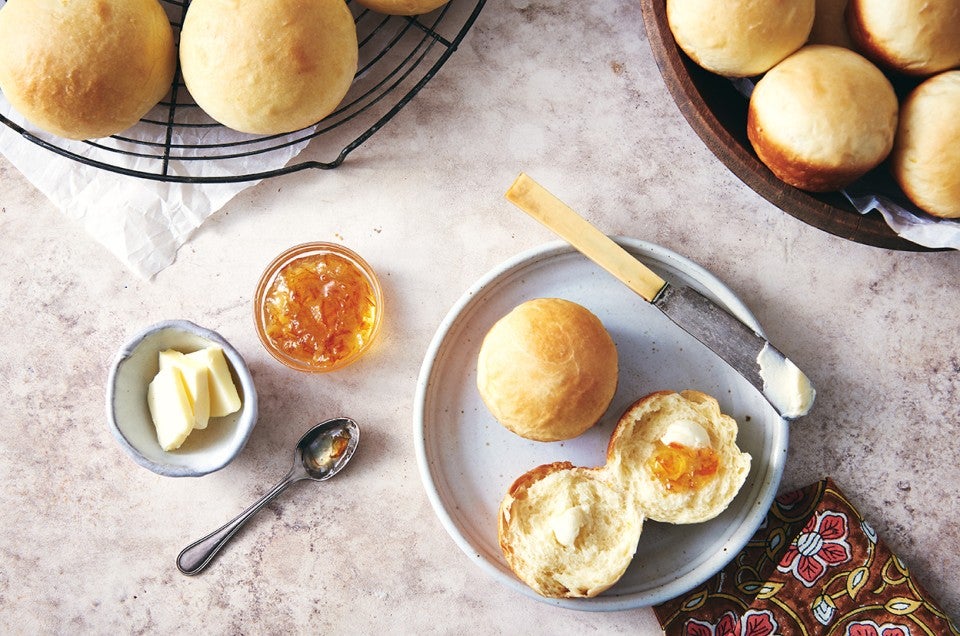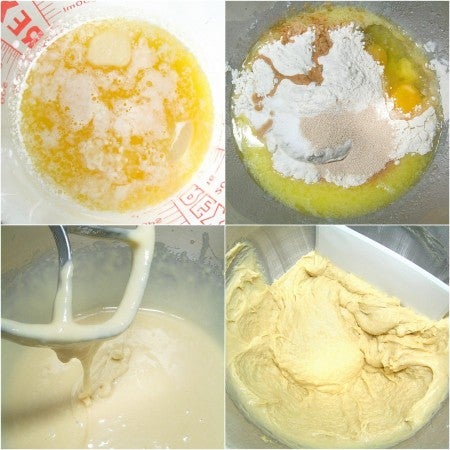


Is this a perfect little yeast roll, or what?
Golden, airy, with a soft, open interior, it's ideal for a pat of melting butter and some apricot jam.
And the nicest part is – this is a no-knead bun. That's right, it's made from batter you simply spoon into muffin cups, and bake.
No sticky hands. No scraping bits of dried dough off the counter.
Just mix; rise; bake.
"Tell me more!"
First of all, who's Sally Lunn?
The name for this soft, mildly sweet bread had its origins in either France or England, depending on which story you believe. One legend has it that Solange Luyon (anglicized to Sally Lunn), a French Protestant, left her native land to settle in England's West Country, where she sold her rich, buttery cakes in the streets of Bath.
To this day, the Sally Lunn Bun, a large, round yeast loaf, is a specialty of Bath bakeries, where it's sold sliced, toasted, and spread with jam and butter, or clotted cream.
Another tale says that Sally Lunn is simply a corruption of the Alsatian solilem(e) or the French soleil lune (sun and moon), and refers to the bread's golden color and round shape. Most sources seem to accept the latter story, though the former is undoubtedly more romantic (which is probably why it came about; why not add a little romance to life whenever you can?)
Sally Lunn became a specialty of Southern bakers in the U.S. a century or more ago. Cookbook author Bill Neal says it's "among the aristocrats of Southern breads." And why not? Light and buttery as brioche, it's much faster and easier to make – perfect for blistering-hot Southern summer days, when all you want to do is relax in the shade with a glass of cold sweet tea.
Since all of us (except you folks in the Pacific Northwest) seem to be having uncomfortably hot Southern weather these days, these individual-size Little Sally Lunns are the ideal way to satisfy your bun craving – with as little steamy effort as possible.
First, let's talk about yeast.
If you already know about SAF Gold, a special yeast for higher-sugar breads – scroll on down to the next photo, because you're in on the secret: SAF Gold works better and faster than SAF Red for sweet yeast breads and rolls.
"So, what's up with that? I thought SAF Red was the best yeast out there."
It is – for all-purpose use. When you're making your basic sandwich bread, pizza, rolls, focaccia, bread sticks, no-knead bread, crusty loaves – anything savory, rather than sweet – SAF Red's your yeast of choice.
But when you're making cinnamon rolls, sticky buns, panettone, challah, anything with a higher amount of sugar in the dough – go for the Gold.
SAF Gold is an “osmotolerant” yeast, which means it plays nicely with sugar. Sugar likes to absorb water; and when sugar’s in bread dough, it pulls water away from yeast, leaving the yeast thirsty. The yeast cells in SAF Gold are bred to require less liquid to function; so they’re better able to withstand sugar’s greedy ways with water.
Bottom line: sweet dough rises better – higher, and faster – when you use SAF Gold yeast.
So, how do you determine if your dough is sweet enough to need a boost from Gold?
Check the amount of sugar in the recipe. If the recipe calls for at least 1 tablespoon sugar per cup of flour, choose SAF Gold – e.g., if you're making a 3-cup-flour loaf, use Gold if the amount of sugar is 3 tablespoons or more.

Place the following ingredients in a microwave-safe measuring cup or bowl; or in a saucepan:
1 cup (227g) whole milk
6 tablespoons (85g) butter
1/4 cup (50g) sugar
Heat to lukewarm, stirring to soften/melt the butter. Pour the mixture into a mixing bowl, and let it cool until it's below 120°F, about 15 minutes.
Add the following to the warm milk mixture:
1/8 teaspoon lemon oil or 1 tablespoon grated lemon rind (zest); or 2 teaspoons vanilla, if preferred
1 1/2 teaspoons salt
2 cups (240g) King Arthur Unbleached All-Purpose Flour
2 large eggs
1 tablespoon instant yeast (SAF Gold preferred)
Beat the mixture on medium speed for about 3 minutes; if you're using a bread machine, program the machine for dough or manual, and mix for several minutes, until everything is well combined.
Add an additional 1 1/2 cups (180g) King Arthur Unbleached All-Purpose Flour to the mixture, and beat for about 3 minutes, to make a soft, cohesive dough. Note: This is a very sticky, wet dough; it's too sticky to knead, so has to be beaten to develop its gluten.
Cover the dough and allow it to rise for 45 to 60 minutes, or until almost doubled in bulk. An 8-cup measure is a neat tool here, since it lets you track the dough's rise easily.
If you're using the dough cycle of a bread machine, simply let the machine complete its cycle.
Lightly grease the cups of two standard muffin pans (24 cups total).
If you don't have two muffin pans (or want to make a loaf, in addition to rolls), lightly grease one muffin pan, plus a 6" soufflé dish or other round, bakeable dish or small loaf pan.
Divide the dough among 18 cups of the muffin pans. If you have a scale, fill each cup with about 40g (1 3/8 ounces) dough; the cups will be a bit more than half full.
If you're using one muffin pan, fill each cup with the amount of dough specified; then shape the remainder into a loaf, and place it in the small pan of your choice.
Cover the pans, and let the rolls rise for 45 to 60 minutes, until they're noticeably puffy.
Towards the end of the rising time, preheat the oven to 350°F.
If you're making muffins plus a loaf, here's what your loaf will look like in a soufflé dish – before rising, it'll fill maybe half the dish. Risen, it'll come up to the top.
Bake the rolls until they're golden brown and an instant-read thermometer inserted into the center of one reads at least 190°F, about 15 minutes.
If you're making a loaf as well as rolls, bake the loaf for about 25 to 30 minutes, tenting it with aluminum foil after 15 minutes to prevent over-browning.
Remove the rolls from the oven.
Are they done? A digital thermometer will tell you for sure. Anything over 190°F, they're fully baked.
Turn the rolls out of the pan onto a rack. Brush with melted butter, if desired.
Wrap completely cooled rolls airtight, and store at room temperature for several days; freeze for longer storage.
Serve rolls with butter and jam, at breakfast or brunch; or as part of an afternoon "high tea."
Big Sally, and Little Sallys. Glistening with melted butter. Light as a feather.
Pass the sweet tea!
Read, bake, and review (please) our recipe for Little Sally Lunns.